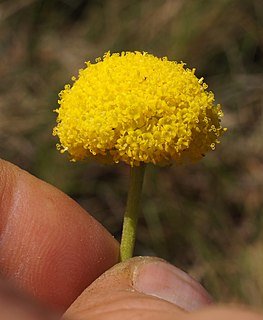
Craspedia is a genus of flowering plants in the family Asteraceae commonly known as billy buttons and woollyheads. They are native to Australia and New Zealand where they grow in a variety of habitats from sea level to the Alps. The genus is found in every state of Australia except the Northern Territory. In New Zealand, Craspedia is found from East Cape on the North Island south to Stewart Island. It also occurs on Campbell Island and the Chatham Islands.

Gnaphalium uliginosum or marsh cudweed is an annual plant found on damp, disturbed ground and tracks. It is very widespread across much of Europe, Asia, and North America. It is very common on damp, arable grasslands, paths, and on acid soils.

Filago is a genus of plants in the sunflower family, native to Europe, Asia, and North Africa. They are sometimes called cottonroses or cudweeds.
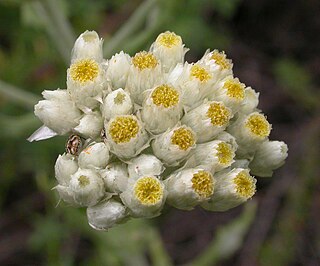
Pseudognaphalium californicum is a species of flowering plant in the daisy family known by several common names, including ladies' tobacco, California rabbit tobacco, California cudweed, and California everlasting.
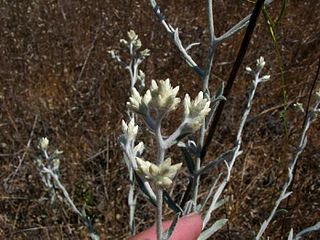
Pseudognaphalium canescens is a species of flowering plant in the daisy family known by the common name Wright's cudweed.

Gnaphalium palustre, known by the common name western marsh cudweed, is a species of flowering plant in the family Asteraceae.

Hesperevax is a small genus of flowering plants in the tribe Gnaphalieae of the family Asteraceae.
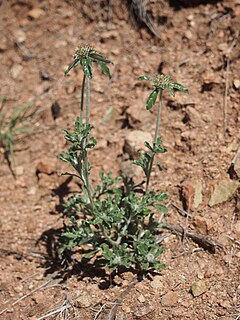
Euchiton sphaericus, the star cudweed or tropical creeping cudweed, is a herb native to Australia, New Zealand, New Caledonia, Taiwan, Java, and Philippines. It has become naturalized in a few places in the United States.

Chrysocephalum semipapposum, commonly known as clustered everlasting is a perennial shrub native to Australia. Clustered everlasting belongs to the family Asteraceae. C. semipapposum produces terminal flowers heads in clusters, mainly between spring and early summer with silver-grey appearing stems and branches. It grows up to 40cm high and 60 cm high, although there have been some varieties which can grow up to 1 m. C. semipapposum is often confused with Chrysocephalum apiculatum or 'yellow buttons', due to their similar appearances. C. semipapposum has 4 different subspecies, however they lack distinctive qualities and are often hard to identify. C. semipapposum is endemic to Australia and can be found in multiple states, most notably within Victoria. The plant is found in a variety of habitats including dry rocky regions. Clustered everlasting often grows sparsely and is rarely found in abundance and can be mistaken for a weed. Clustered everlasting has many uses, including as a source of nectar for butterflies, cut flowers or as an addition to a garden.

Euchiton is a genus of flowering plants in the family Asteraceae. They are native to Australasia and the Pacific. Some have been introduced far outside their native ranges.
Cymbolaena is a monotypic genus of flowering plants in the aster family, Asteraceae, containing the single species Cymbolaena griffithii. It is native to Asia, where it is distributed from Turkey to Pakistan. It is one of several genera in "the Filago group," and some authors include it within the genus Filago.

Psilocarphus tenellus is a species of flowering plant in the aster family known by the common names slender woollyheads and slender woolly marbles. It is native to western North America from far southwestern British Columbia to Baja California, where it grows in seasonally wet habitat, such as vernal pools, as well as coastline and disturbed areas.
Pseudognaphalium saxicola, common name cliff cudweed or rabbit-tobacco, is a rare plant species endemic to Wisconsin. It grows on ledges and in cracks in shaded limestone cliff-faces, usually those facing south or east.
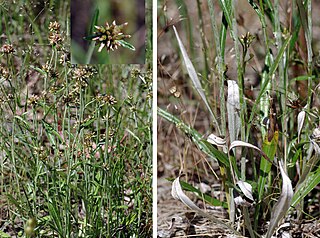
Euchiton collinus, the creeping cudweed, is a herb native to Australia and New Zealand. It has become naturalized in a few places in the United States.
Gamochaeta stagnalis, the desert cudweed, is a species of flowering plant in the family Asteraceae. It is native to Mexico, Guatemala, and the southwestern United States.
Gamochaeta argyrinea, the silvery cudweed or silvery everlasting, is a North American species of flowering plant in the family Asteraceae. It is widespread across the southeastern and south-central United States from Delaware south to Florida and west as far as southeastern Kansas and central Texas. It has also been found in Puerto Rico and in northern California.
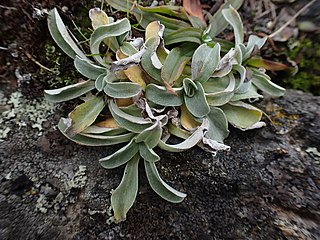
Gamochaeta ustulata, commonly named featherweed or Pacific cudweed, is a North American species of flowering plant in the family Asteraceae. It is native to the western United States and southwestern Canada, in British Columbia, Washington, Oregon, and California. It is found primarily on seaside hills and in the Coast Ranges, with additional populations inland.
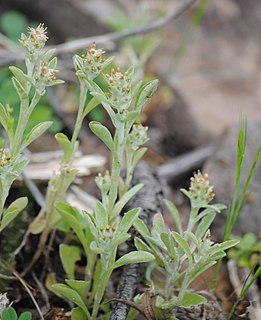
Gamochaeta pensylvanica, the Pennsylvania cudweed or Pennsylvania everlasting, is a widespread species of flowering plant in the family Asteraceae. It is native to South America and introduced into Eurasia, Africa, Australia, and North America. The pensylvanica epithet is a misnomer, as the plant is not native to Pennsylvania and only marginally naturalized there.
Gamochaeta simplicicaulis, the simple-stem cudweed or simple-stem everlasting, is a species of flowering plant in the sunflower family. It is native to South America and has become naturalized in Australia, New Zealand, and the southeastern United States.

Gnaphalium polycaulon, the many stem cudweed, is a plant species in the family Asteraceae. It is widespread across much of Mesoamerica, South America, and the West Indies, and naturalized in parts of Asia and Africa.















